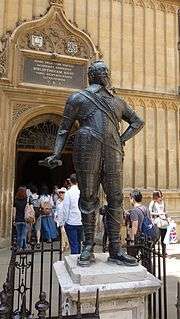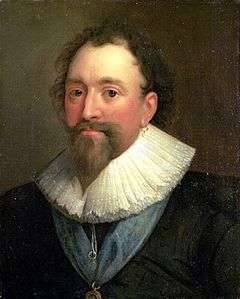William Herbert, 3rd Earl of Pembroke
| The Right Honourable The Earl of Pembroke KG PC | |
|---|---|
|
William Herbert, by Daniel Mytens, oil on canvas, 1625 | |
| Born | 8 April 1580 |
| Died | 10 April 1630 (aged 50) |
| Spouse(s) | Lady Mary Talbot |
| Parent(s) |
Henry Herbert, 2nd Earl of Pembroke Mary Sidney |
William Herbert, 3rd Earl of Pembroke KG, PC (8 April 1580 – 10 April 1630) was the son of Henry Herbert, 2nd Earl of Pembroke and his third wife Mary Sidney. Chancellor of the University of Oxford, he founded Pembroke College, Oxford with King James. He was warden of the Forest of Dean, and constable of St Briavels from 1608 to 1630.[1] He served as Lord Chamberlain from 1615 to 1625. In 1623, the First Folio of William Shakespeare's plays was dedicated to him, together with his brother, Philip Herbert, 1st Earl of Montgomery.
Life and marriage



William was a bookish man, once tutored by the poet Samuel Daniel, and preferred to keep to his study with heavy pipe-smoking to keep his "migraines" at bay. His father negotiated a marriage between the young Herbert and Bridget de Vere, the granddaughter of William Cecil, 1st Baron Burghley. Offered 3,000 pounds and an annuity to begin at Burghley's death, the prospective groom wanted immediate payment of the annuity. The negotiations failed, and he remained single.
At the age of twenty, he had an affair with Mary Fitton (who has been suggested as a possible model for the Dark Lady of the sonnets), whom he impregnated. Admitting paternity, he refused to marry her and was sent to Fleet prison where he wrote verse. In 1601, Mary gave birth to a boy who died immediately. He petitioned Sir Robert Cecil and was eventually released, though he and Mary were both barred from court. He married Lady Mary Talbot, the dwarfish and deformed daughter of Gilbert Talbot, 7th Earl of Shrewsbury, on 4 November 1604.
Herbert had an affair with his cousin, Lady Mary Wroth, daughter of Robert Sidney, brother of Mary Sidney, Countess of Pembroke, Herbert's mother. The relationship produced at least two illegitimate children, a daughter, Catherine, and a son, William. In “Herbertorum Prosapia” a seventeenth-century manuscript compilation of the history of the Herbert family, held at the Cardiff Library, a cousin of the earl of Pembroke, Sir Thomas Herbert records William Herbert’s paternity of Wroth’s two children.[2] He died in 1630, aged 50 and his titles passed to his brother, Philip Herbert, 1st Earl of Montgomery. He was buried in Salisbury Cathedral in a family vault in front of the altar.
Herbert and Shakespeare's sonnets
Herbert has been seen as the "Fair Youth" in William Shakespeare's sonnets, whom the poet urges to marry. Some years Shakespeare's junior, he was a patron of the playwright and his initials match with the dedication of the Sonnets to one "Mr. W.H.", "the only begetter of these ensuing sonnets." The identification was first proposed by James Boaden in his 1837 tract On the Sonnets of Shakespeare. E. K. Chambers, who had previously considered Southampton to be the Fair Youth, changed his mind when he encountered evidence in letters that around 1595 young Herbert had been urged to wed Elizabeth Carey, granddaughter of Henry Carey, the Lord Chamberlain who ran Shakespeare’s company. But he refused to marry her.[3] In her Arden Shakespeare edition of the Sonnets, Katherine Duncan-Jones argues that Herbert is the likelier candidate.[4] The First Folio of Shakespeare's plays was dedicated to "incomparable pair of brethren" William Herbert and his brother Philip Herbert.
Herbert was also an important patron of the arts[5] and a member of the Whitehall group.
Notes
- ↑ British History Online
- ↑ Mary Ellen Lamb, Wroth , Lady Mary (1587–1651/1653), Oxford Dictionary of National Biography, Oxford University Press, Sept 2004; online edn, Jan 2008.
- ↑ Williams, Charles, and E. K. Chambers. Short Life of Shakespeare With the Sources. Oxford: Oxford University Press, 1933 (1956), pp. 129-30.
- ↑ Duncan-Jones, Katherine, ed. Shakespeare's Sonnets (1997), pp. 52-69.
- ↑ National Portrait Gallery
References
- Haynes, Alan. Sex in Elizabethan England. Gloucestershire: Sutton Publishing Limited, 1997. ISBN 0-905778-35-9
External links
| Wikimedia Commons has media related to William Herbert, 3rd Earl of Pembroke. |
